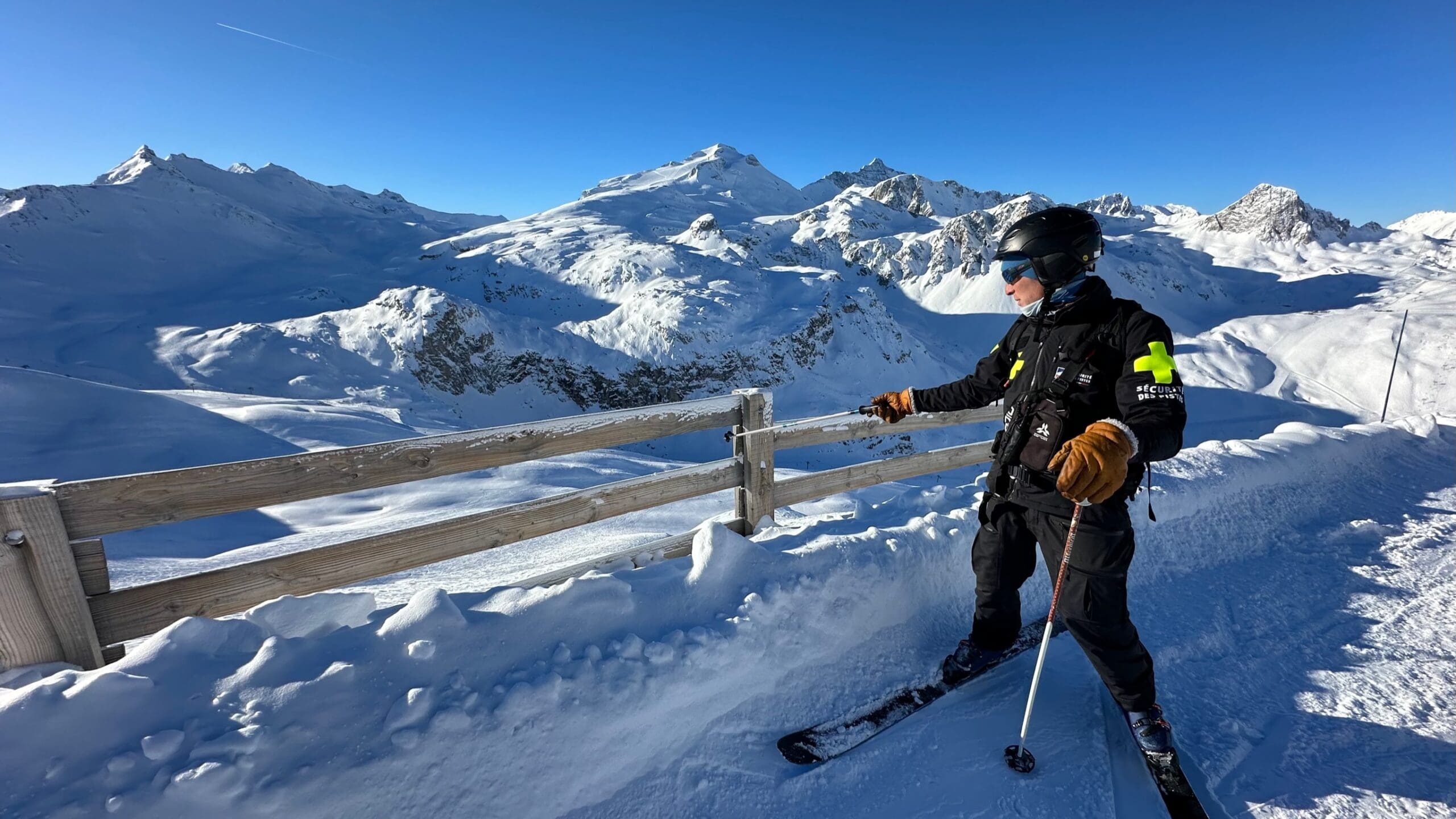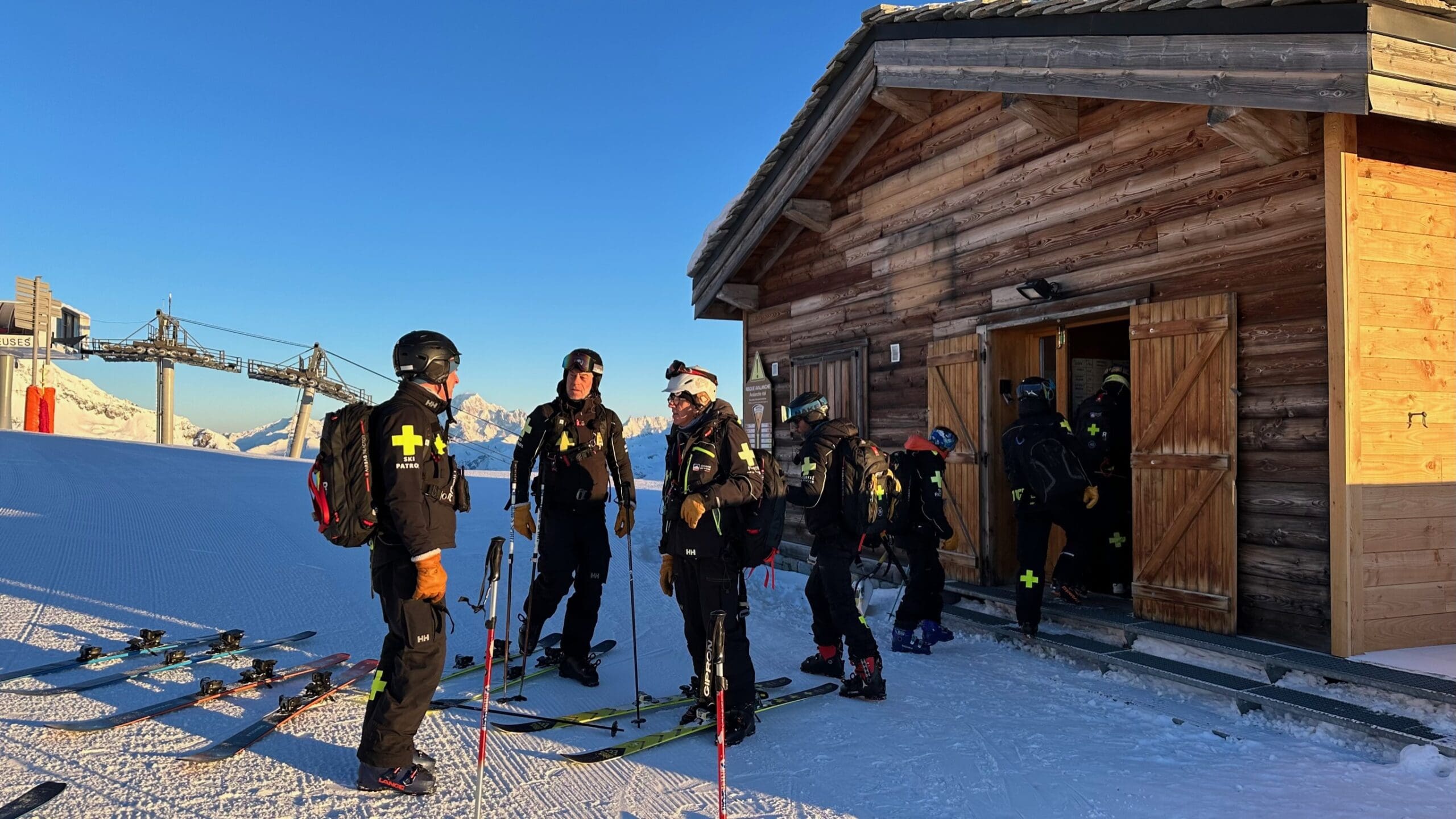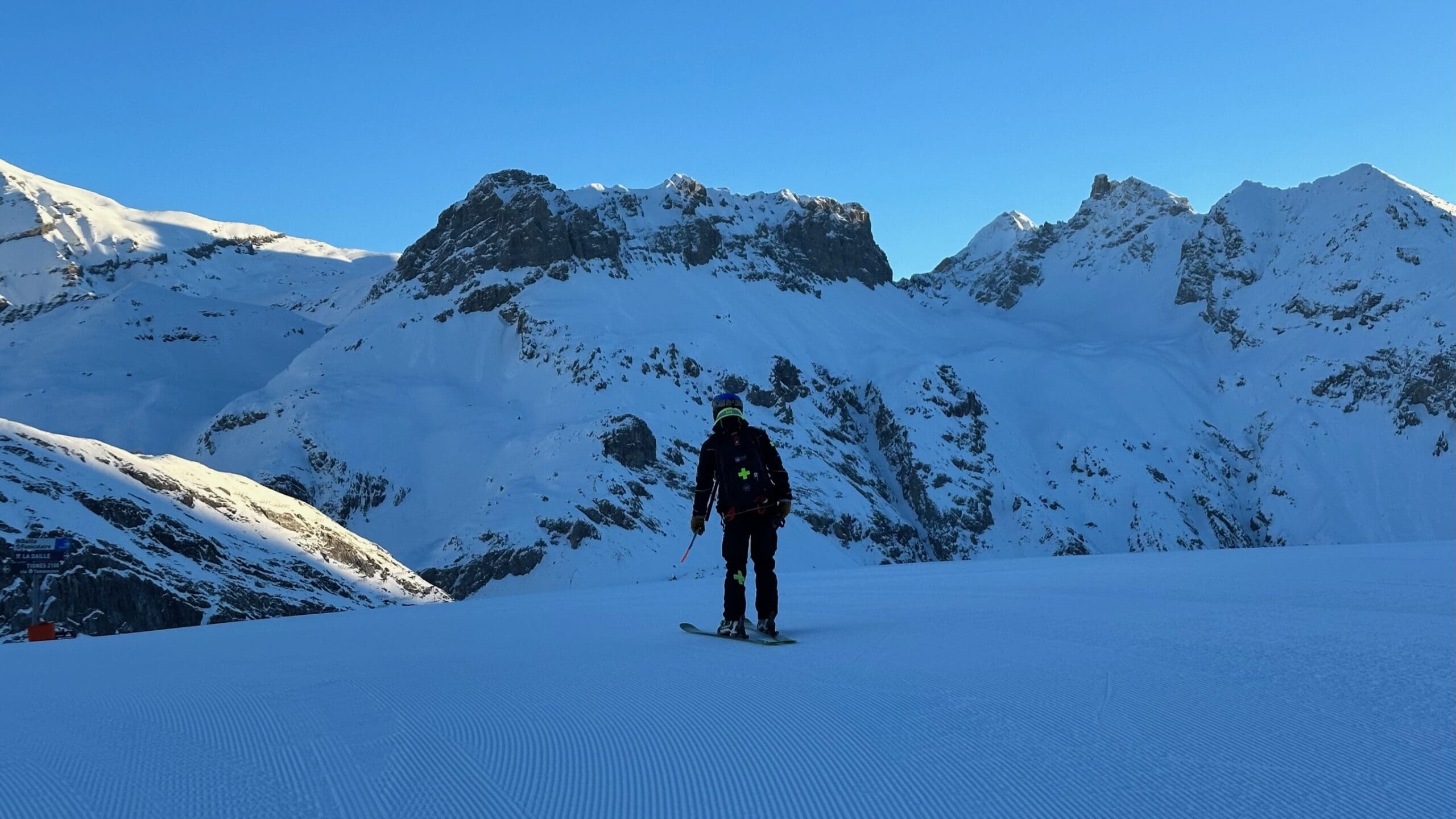How many of us regularly admire and marvel at the majesty of the mountains around us? What tiny percentage of us give any thought to the safety and security going on behind the scenes by the Mountain Patroller teams?
By Chris Glynne

Sure, if you’ve ever been witness to the work of these teams rescuing you, or a person you know, then I’m confident you felt immense gratitude at the time… but how often do you reflect on their much wider role of proactively keeping you safe? Safety, we take for granted, amongst the myriad of ambient risks presented by that same majestic wilderness.
During the 2022-23 Season in Tignes, France, I met Pete Richmond. Pete is a rather unusual example of this profession, out here – a British Ski Patroller. It was through Pete that I was ultimately able to experience and now highlight the realities of these dedicated men and women – referred to in France as Pisteurs.
It was on 12th January 2024 that I was given special dispensation to shadow Pete and the team he’s part of. I thought it might be a challenge to do them justice… that is until I discovered the immense scale of breadth, depth and attention to detail. What I concluded is that if you read my story and multiply by 10, you’ll still fall short of how much they do for us as snowsports lovers.
The structure in Tignes combines a multitude of responsibilities under one large municipal team called ‘La Regie des Pistes’ (Piste Management).
The ‘Mairie’ (Mayor) of Tignes is President but delegates all responsibilities to their ‘Director General’. This DG role is mostly strategic and delegates all day-to-day operational responsibilities to the ‘Director of Operations’. In turn, this role oversees various departments but the largest is the Pisteur team – and it’s big, 56 staff in all.
The Tignes ski area is divided into four ‘Secteurs’, each one has a team of Pisteurs headed by a ‘Chef de Massif’ (sector chief) and an ‘Assistant Chef’. The ‘Grand Motte’, ‘Palet’ and ‘Tovière’ sectors each have a team of 12 with 8 always on duty. The ‘Aiguille Percée’ sector is the largest, by area, and has a complement of 20 with 12 typically on duty. Although each member is part of a sector team they all occasionally help out across teams when one area is under pressure.
This is before we even consider the wider team of piste groomers, snow-makers, mechanics, off-season projects team, admin and rescue call-centre staff. The scale melts my mind as I try to soak it all in. I wonder how I’ll pay homage to all of them.
Pete is part of the Tovière team, so that’s who I’m embedded with for the day. Little did I know what to expect, as the dawn of the 12th arrived, but this is how it unfolded:
07:30 I’m out of my apartment door – ‘piste bashers’ still sparkle around the mountain like stars twinkling amongst the brightening dawn sky.
07:45 I meet Pete at his usual bus stop; a 5 minite ride from his Headquarters. We chat about what to expect and what I hope to get out of the day, etc.
I summarise by saying “I want to help people appreciate what unsung heroes you all are”. He looks embarrassed.
07:55 Pete goes up to Pisteur HQ for his morning briefing, while I wait at his sector’s main Telecabine base.
08:00 There are numerous locals out walking their dogs, the ski lift teams from STGM are prepping for startup; road clearing trucks rumble away and chirp their warning beepers like a strange dawn chorus; other Pisteurs go by on skidoo with bundles of piste poles and netting.
08:20 The team I’m shadowing assemble at the Tovière gondola. One of them walks over, says hello and changes the avalanche risk sign from 3 down to 2. “A good day!” I say, smiling. “Let’s hope so” she replies, reciprocating the smile. I’ve just met the lovely Marina.
08:25 Even as we are heading up the gondola, Pete is immediately scanning. I’m throwing out questions about what happens before opening. He replies only once he’s studied something that caught his eye; “Right now we’re looking for ‘primary dangers’ that might halt a piste safely opening”. He continues to scan but explains that it’s important to note if any of the orange protection mattresses are missing, poles blown down/snapped, etc.
08.30 There’s little time to waste… the hut is opened. Chef de Tovière, Jean-Pierre, starts the co-ordination. Marina is the principal on ‘Rescue duty’ today and immediately starts checking all the kit is present and correct. Each pisteur does roughly a 10 day cycle as Rescue lead. The rest of the team start sweeping down pistes that they’ve been allocated.
Pete gives me a rapid heads up and we are off down his allotted runs – again scanning for primary dangers. He slows past a snow-cannon; “that protection mattress needs raising” he notes out loud. A new snow-cannon mound made overnight is given a couple of quick wiggle turns. This is so people can see his track against the almost invisible mound they might otherwise hit at speed. There are several piste marker poles, known as ‘jallons’ which have fallen… he quickly rights them. “We’ll come back to remediate a low mattress but probably won’t open a piste if there’s a missing one”, he explains.
As we near the end of this piste, he scans the remaining section below and concludes all is OK. This gives us enough altitude to track, off-piste, over to the bigger, nearby run. We meet up with his colleauge, Gauthier, and help with putting out the ’SLOW’ and ‘CROSSING’ signs. Each night they are collected, tidily rolled up and placed out of the way of the piste groomers. Five minutes later they are all back out, courtesy of Pete’s power drill.
08:45 Pete sends his radio confirmation about both pistes being ‘OK to open’, with a note about the mattress. His decision can be overridden but if he says a piste can’t open yet then it probably doesn’t get opened… yet.
What astounds me is the information he is absorbing, processing and deciding upon as we ski down. They ski super-fast but remain incredibly vigilant. It’s like they have eyes in all sides of their head. Within 20 minutes, of us having reached the top of the Tovière, all this sector’s pistes are cleared to open.
Next we take a more relaxed cruise down into La Daille – part of the twinned Val d’Isere resort. We pass the eerily silent ‘Folie Douce’ – a cauldron of early-aprés fun later in the day. He pauses to explain that we’re checking the route which the rescue team might need to take in certain circumstances.
08:55 Now we are waiting for the La Daille gondola to be opened… even Pisteurs have to wait sometimes. Pete explains how even missing or fallen piste poles can be a major hazard in poor visibility. People don’t realise they’ve left the piste and get easily lost or fall into hollows or off ledges, with major consequences.
09:10 At the top of the bubble we meet two Val d’isere Pisteurs and chat. One can tell straight away there is a great camaraderie across their shared mountain, even though one can also tell there is a good dose of banter.
09:15 We take the chairlift back to the Tovière peak.
09:25 It’s straight back to the hut to fill out the official paperwork; recording the checks and remediations that have been reported by radio. It is taken very seriously… any risk must be recorded and marked once remediated.
09:35 Time for coffee. The team compare notes and actions required from the piste screening runs.
09:49 I notice Pete has disappeared, so I wander outside. The peak is already awash with keen skiers and boarders everywhere. I’m reminded of one of the dangers he pointed out earlier… I watch him knocking a substantial build-up of snow-cannon ice, which has accumulated on the signposts overnight. “We wouldn’t want that falling on someone’s head” he says, as he strides back with his ‘jallon’ knocking pole.
Meanwhile someone has popped into the hut to ask what the off-piste conditions are like. They are given the information from the avalanche bulletin and urged to still be careful and take usual off-piste precautions.
10:00 Pete has been given special dispensation today to show me everything that goes on. He re-iterates his remediation notes to his team-mates and liaises with Jean-Pierre about taking me to see ‘Central HQ’. 5 minutes later we are out of the door and heading down towards the nerve centre.
10:20 HQ Centrale is a massive complex of everything that enables the ski area to operate.
First stop is the main office floor where all the co-ordination takes place. The Emergency Call Centre is the most obvious hub of activity. Two ladies are busy liaising with callers who need rescue help on the mountain. It seems like a quiet day in our hut but clearly there are other sectors with less fortune for their visitors.
Pete introduces me to a passer-by, Christophe; “This is our Quartermaster”. I make a poor attempt at 007 humour, he smiles nonetheless. We later visit Q’s Aladdin’s cave. It’s brimming with everything from the obvious pisteur kit and piste poles through to search and rescue drones… but no fully-kitted-out Aston Martin.
We meet Cecile who manages pretty much all logistics and finance; then Delphine who is HR manager for the 106 people making up the full team. Other offices hint at the extraordinary work undertaken outside winter season. Pete re-iterates that the Pisteurs are just the more visible part of the team that makes this resort such a great snowsports paradise. It re-enforces that this is a year round collective effort – the Winter activities merely bring that effort to life.
Finally, in the offices, Pete leads us to the top table. The Director General, Jacques, is away today but I’m introduced to Olivier, the Chief of Operations. He smiles and generously offers access to anything that would be helpful. I sense he knows Pete is already on the case with exactly that.
I’ve been tapping notes away wildly on my phone, barely taking it all in. I’ve all but depleted the iPhone battery, pleased with myself I’d grabbed the powerbank before leaving home this morning. Pete smiles and says “We’ve not even started the lower levels yet”.
In the lower floors we have engineering workshops and more of Q’s store-rooms. They contain the much larger items such as: signposts, piste name poles and an immense array of snow-making parts.
We walk through the vehicle storage rooms, which are like mini aircraft hangers. It’s here we meet Ian, the head mechanic. He’s another Brit and arguably one of the most important people in the team. He leads a five-strong troop who look after all the mountain vehicles: skidoos, quadtracks and of course the 17 piste bashers in service across Tignes. At a rough €500k per machine these piste grooming behemoths are both impressively brutish and tech-sophisticated deftness all in one. They can move tonnes of snow per minute to within 6cm accuracy of intended piste perfection. Each beast requires a ~€20k service about once per season. However, there are regular breakdowns due to the intense workload they suffer. Typically there are 5 requiring repair at any one time. Today must be an easy day because there are only 3 in the hall. Ian points out that he had two ‘on-mountain’ repairs yesterday. He explains about replacing cat-track grippers, hydraulic leaks, electrical issues…
As we shake hands and say goodbye, I mentally wince at how you do any of that, on-mountain, in seriously sub-zero temperatures… and in the dark.






